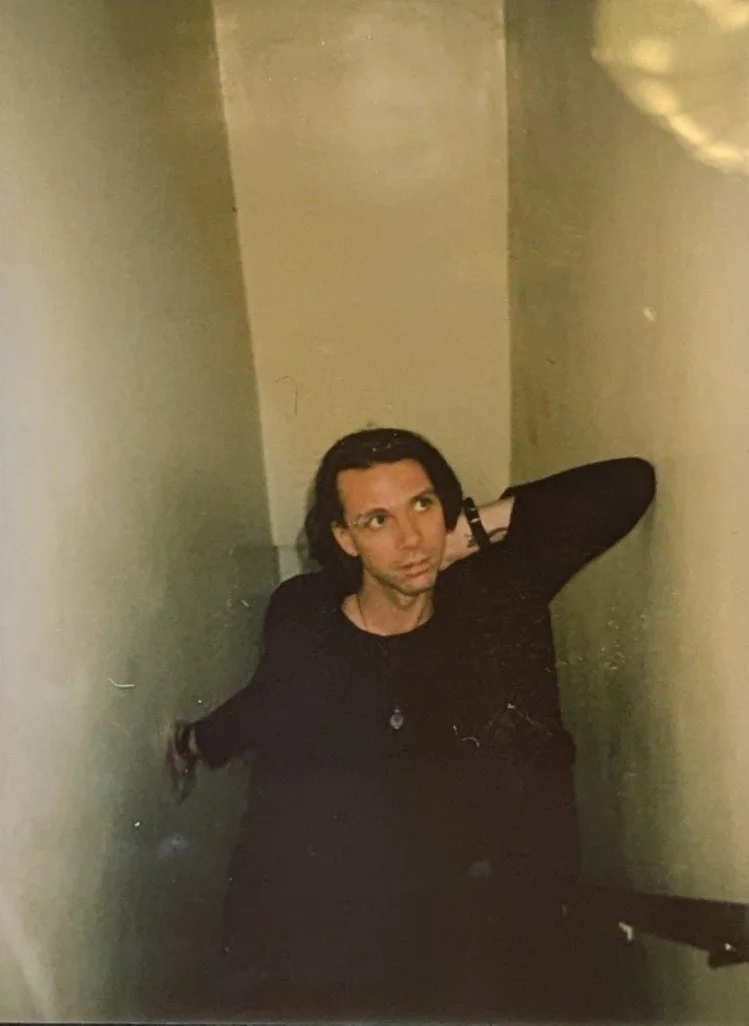Photo by Lindsay Hargrave
Relatively new to Philadelphia, Noah David Roberts has already firmly rooted themself into the cultural and literary hive of the city through founding a monthly reading series (Scribes on South), co-founding a journal (Graphic Violence Lit), and hosting and performing at other various events. In other words, they have created a buzz. Their latest work, SWARM, as the title suggests swarms with intensity and startling metaphors. The book can feel as sharp as a hornet’s sting and offer the salve for the sting in alternating measure.
SWARM revels in a celebration of the narrator’s bio-mythography. The narrator is nonbinary, and their individual bio-myth begins when they step on a hornet’s nest, a papery yet ultraviolent construction. The hornet’s nest being as what Roberts writes in the artist statement/afterword, “the violence of what has become the gender binary.” One poem among several where the origin story of the bio-myth is richly explored is the poem, “Drifting Through False Front Architecture.” The poem begins with haunting, cinematic lines:
The thing about a ghost town is that
the inhabitants are translucent
which means, I can see trueness
in capillary skin. Chain railings &
chicken wire rust in early summer,
the shade of the sun, nothing can evade.
The poem opens like an old Western and entices the reader with how this metaphor will reveal itself and what presuppositions about gender will dissolve: “Ghost stories/ are a little played out, don’t you think?” The narrator’s body metamorphoses into water, arsenic, a viper until this crackling poem ends with
A page left blank
like entire spaces of time. When I
was a kid I stepped on a hornet’s nest,
& now the grass is seeded differently.
Earlier in the collection, “Wasp Affirmation,” divebombs into the wasp/hornet metaphor and serves as a sort of tagline for this collection with the opening lines: “I have one mission & one mission only: feed & kill.” The rhythm of the language intimates an angry wasp in flight:
I see
nothing but prey stranded & paralyzed
in sight of our numbers, my swarm
of genderfucked anger, buzzing.
This poem stings, rears back, and stings again with its heightened and precise diction, perhaps nowhere more so than the penultimate sentence: “I pray to queen to save my carvedout exo,/ maybe that is what it takes/ to turn a boy girl.”
The cinematic universe depicted in “Drifting Through False Front Architecture” is also reflected in “Clockwork Monkey.” The most famous and perhaps the most unsettling image of eyes being propped open is alluded to
There is violence in my manhood
that intrepidly spins the spectrum
& dilates my memory. Lysergic eye
-drops & ketamine couldn’t save
those condemned eternity
moths around a low love.
A reader may wonder how a poet that starts so vividly, so violently would end. “Clockwork Monkey” ends with what I feel is the most lyrical image in the collection:
I find the pit of my horror wealths
of knowledge, a passion
lived in a cloud against a feminize
azure sky.
Towards the end of the collection, the narrator calls back to their origin story. In “Wrath,” the narrator explains
Something
happened to me when
I stepped on that nest &
now I am different
This book is shaped as a metamorphosis, a butterfly coming out of its cocoon, or more germanely, a wasp outs of its easily destructible, yet dangerous, nest. An unnamed person tells the narrator, presumably trying to sway who they will become, “ur welts will melt to/ dissipation & ur memory/ of this time will fade.” This collection is proof that the narrator formed their identity without fear of ultraviolence. Instead, they
sweep
wasp carcasses from under
the table, seeing that they are
my manhood. Decrepit
& crusted to the floor
like I used to be. A wasp
will survive anything but
my own feminine wrath.
With SWARM, Roberts and their narrator explore a world hostile to the nonbinary, in thrall to the patriarchy. Literally, nonbinary folks have to push their way out of a flimsily constructed world and, in a way, rebirth themselves. This poetry beauty is a necessary addition to transgender literature. One that uses a sustained and compelling metaphor to relay that experience to any reader attuned enough to hear the buzz. Believe the buzz; give into the buzz; read this book!
Sean Hanrahan is a Philadelphian poet originally hailing from Dale City, Virginia. He is the author of the full-length collection Safer Behind Popcorn (2019 Cajun Mutt Press) and the chapbooks Hardened Eyes on the Scan (2018 Moonstone Press) and Gay Cake (2020 Toho). His work has also been included in several anthologies, including Moonstone Featured Poets, Queer Around the World, and Stonewall’s Legacy, and several journals, including Impossible Archetype, Mobius, Peculiar, Poetica Review, and Voicemail Poems. He has taught classes titled A Chapbook in 49 Days and Ekphrastic Poetry and hosted poetry events throughout Philadelphia.


